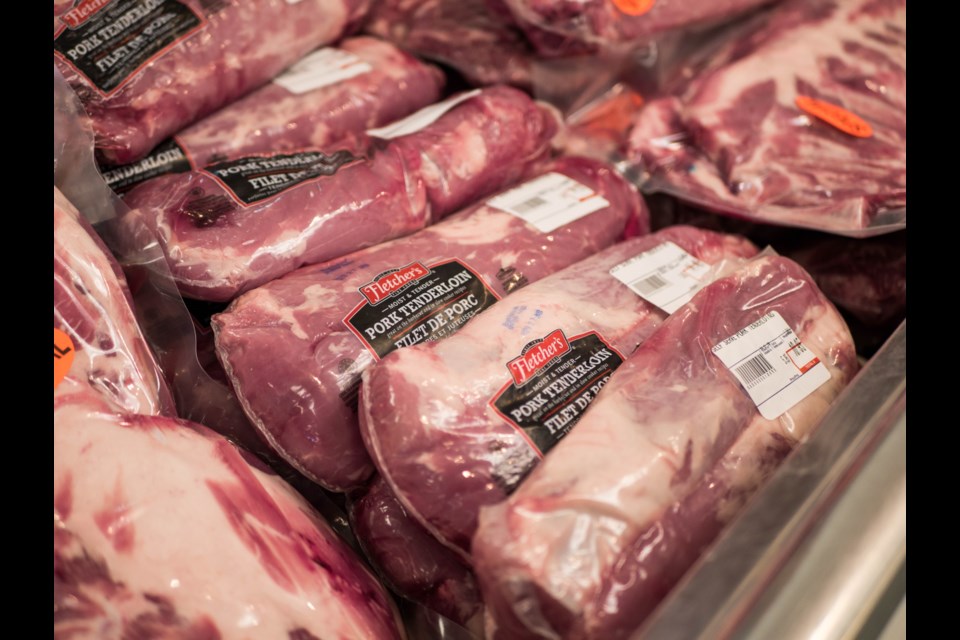Whether you have company coming over for dinner, or you just want to treat yourself to a delicious barbecued steak, choosing the wrong cut of meat is the “prime” cause for ruining your dish. Shopping for meat can be an intimidating process. Some customers have a difficult time understanding what it is they are shopping for when they inspect the products behind the glass casing of their local butcher shop.
Leonard Hillman, Brendan Schmidt and Brendan Doyle are local meat cutters. These butchers have provided a few tips on how to choose the best cuts of meat when shopping for your dinner preparations.
Tip One – Fatty vs Lean Cuts
“A good cut of meat has a certain amount of marbling and the fat is trimmed.” Brendan Doyle, a meat cutter at North Country Meats, says.
Marbling includes the little pieces of white fat that runs through the meat. Marbling can add flavour and change the way a piece of meat cooks and tastes. But buyer beware: meat with lots of marbling can also turn out chewy if cooked incorrectly. Fatty meat needs to be cooked properly, or else it can make your finished steak tough.
“If you are going to purchase a cut that shows a lot of marbling, it might be best to stick to thin cuts. It helps to prevent meat from getting rubbery” Doyle adds.
However, Doyle warns against purchasing a cut that is too lean. “A lean cut may cook to be tender, but also loses the flavor that the marbling would have added” he says. Doyle concludes by suggesting a customer seeks out a cut that does have marbling, but is not riddled with it. That way, the cooked meat has flavor, but is also tender.
Tip Two – Ask for Custom Cuts
Brendan Schmidt, another local meat cutter, suggests that customers should take advantage of custom cuts, “When you walk into a butcher shop, you have the opportunity to ask for a thicker cut, or a thinner cut. A cut with more or less fat”.
He adds that customers can save money on this process when they buy in bulk. “If you purchase a whole piece of meat, you can ask your butcher to cut it down for you. It’s often more cost effective than purchasing a bunch of smaller pieces, separately”. Schmidt also mentions that meat is safe to store in the freezer. Once you have your meat packaged into smaller portions, you can keep it in the freezer and remove the individual cuts as needed. It’s the perfect method to always have a dinner option on hand.
When a customer asks a butcher to customize their order, the butcher is typically happy to do so. It provides the customer with the opportunity to get what they really needed, with a quality product suited for the meal they are looking to prepare.
Tip Three – Ask Questions
Leonard Hillman, who is also a local butcher, believes that many customers tend to be intimidated, especially if it is their first time in the store. However, butchers are prepared to discuss cuts with customers, and are happy to answer questions. Butchers care about their customer’s overall eating experience. They want to be able to provide a good experience for their patrons, and are able to suggest different cuts, as well as cooking tips. They are there to assist customers every step of the way.
“Butchers are experienced when it comes to understanding meat. Customers can ask questions and expect answers that are based on this experience” says Hillman. “Whether you need to know the difference between types of steak or you want to know the best way to cook your cut, we know our product and we can help provide guidance.”
Kevin and Darlene Doyle, co-owners of North Country Meats, are passionate about helping people confidently choose quality cuts, and ultimately, help make their meals even tastier. The duo believe that having the opportunity to select your cut of meat can ultimately dictate what your meal will taste like. Kevin Doyle ends by suggesting that, “The way you plan to cook your meal should be an indicator of the cut you purchase. And we’re happy to help you pick that cut. When you’re working with a quality product, you’ll find it cooks easier. It tastes better. It’s a better eating experience overall”.
Taking in the vast product offerings of a butcher shop can be a learning process to some, but the cutting team is happy to share ideas. Kevin Doyle encourages shoppers to give local butcher shops a chance at serving them. With a guiding hand from expert meat cutters, shopping for quality cuts is made easier, and meals can be even tastier.



